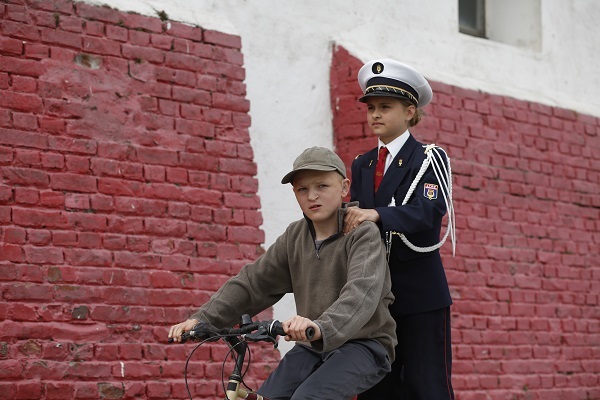French Film’s Master Magician Bruno Dumont Turns Tragedy Inside Out

Li’l Quinquin, a film by Bruno Dumont. Photo Credit: Kino Lorber.
GALO: When she says, “Do I satisfy you?” it’s very amusing…to have him grab her and kiss her. Have you worked with very young actors before?
BD: No, it’s the first time.
GALO: You had not worked with this actor before?
BD: No.
GALO: How did you find him?
BD: I put an ad in the town’s paper. A lot of children came and he came with someone who wanted to audition, but he didn’t intend to audition himself. It’s always that way.
GALO: Maybe you can tell me about the locale of the film (a village in Northern France near the sea, where the English channel is within view). It’s very evocative of isolation and beautiful at the same time. Do you know this locale from your personal experience?
BD: Well, I was trying to show beauty, even though the context is horrendous with the crimes. That’s where I live, where people swim in the Channel.
GALO: There was an article I was reading on the Internet that mentioned your association with a group of French film artists; I believe they were called the “French Extremists?”
BD: I think that’s just a rumor that was started by journalists. They put you in a category. I am not part of any group.
GALO: About your creative direction, when you think of the power of a single still, the sequences when the major characters or a grouping of an ensemble are gathered facing the camera, the friends of Li’l Quinquin, for instance — the stillness of that moment — it’s as if you could freeze the film in that place. Before you became a filmmaker, did you have a concentration in photography or painting?
BD: My inspiration for making movies, my food, what feeds me, is not film, it’s actually painting.
GALO: I understand that. When I’m tired of a day of writing, always thinking about the verbal part of it, I enjoy the visual by painting.
BD: It’s calming because it’s still, so it makes you think and you can meditate. Film is harder to make because it’s movement.
GALO: But there’s definitely stillness in some of your film characters.
BD: Oh, yes — certainly.
GALO: There’s that moment when the detective is in the car with his lieutenant and he’s looking out at sea. “I’m just thinking,” he says, “the sea…” Then you have the craziness too — the squad car going in circles, the bumper cars at the amusement park going everywhere and nowhere, the frenetic motion of the kids…and then that stillness. In the theatre, we have what we call the “pregnant pause.”
BD: It’s a little like the painter Edward Hopper. He doesn’t focus on the subject but what’s next to it, just on the edges of the subject. He’s a very cinematic painter because he’s placing himself at the beginning of his subject. What is uneventful is what the main event is.
GALO: In the chapel in the film, there’s an objectification of things, a concentration of all these other things going on — when Li’l Quinquin’s in the chapel waving the sensor, then there’s the business with getting the microphones right. You don’t feel the need to explain. At the top of the film, little Eve is blowing a horn. We don’t have to know why she has a horn. The story flows and we will see where it fits later. To bring up the future, do you think you will continue to create films in this tragicomic vein?
BD: Oui. I’m going to persevere and do more.
GALO: Do you find life itself has a tremendous absurdity about it?
BD: In life, there’s always a balance of things. Not just one or the other, so in truth I find myself in this balance.
GALO: Out of curiosity, it’s also been mentioned that you’re an atheist in your approach. Is that true?
BD: Oui, Oui, because I think that film is sacred. My approach is that life is spiritual and you actually live through that aesthetic. It’s not that I don’t believe in God. God is film.
GALO: In other words, the spiritual we find is right here on earth.
BD: It can be standing in front of a painting…yesterday I went to the Museum of Modern Art and I saw André Derain. It was a very spiritual experience.
GALO: There’s a scene in the film, the horror of his finding the woman’s body on the beach, and he suddenly remembers Peter Paul Rubens (a Flemish Baroque painter). The commingling of these two elements, that even a terrible thing can suggest something else — a thing of beauty.
(At this point in the interview, a brief discussion ensued between Dumont and myself about a wall poster advertising Dumont’s film “Camille Claudel 1915,” starring Geneviève Bujold, that was just released last year.)
GALO: I have not seen your version, but I remember how much I enjoyed a biofilm about Claudel years ago, starring Isabelle Adjani; a fascinating character, the artist. I must catch more of your earlier films. I guess I have my homework cut out for me. [Rising, shaking hands.] Well, enchanté. It’s been delightful.
BD: Enchanté. And thank you.
Video courtesy of NDM Ventas Internacionales.
Featured image: Photo Credit: Kino Lorber.
